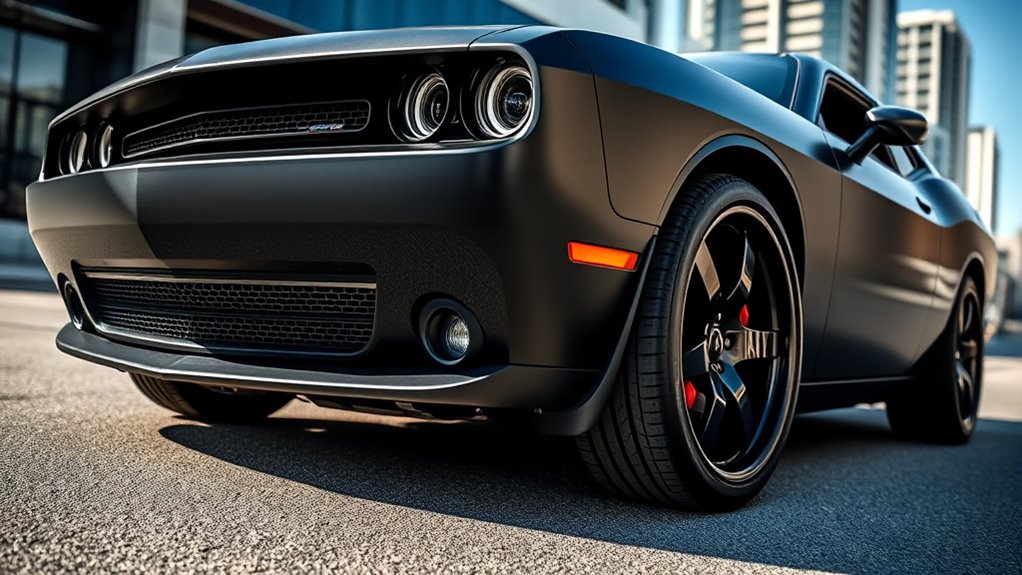After lowering your Challenger, you should prioritize a professional suspension alignment to adjust camber, caster, and toe angles, ensuring even tire contact and preventing driveline stress. Also, re-balance your tires to fix any weight distribution issues caused by the new stance. Upgrading suspension components and regularly inspecting for looseness can further prevent vibrations. Proper setup and maintenance are key—stick around to discover how detailed adjustments make all the difference.
Key Takeaways
- Have a professional perform a proper wheel alignment to ensure correct camber, caster, and toe angles after lowering.
- Rebalance tires to compensate for altered weight distribution and prevent vibrations at highway speeds.
- Upgrade suspension components, such as control arms or coilovers, to maintain proper angles and reduce driveline stress.
- Regularly inspect and tighten suspension parts to prevent misalignment and associated vibrations over time.
- Seek expert assistance for setup and maintenance to ensure optimal driveline angles and a smooth ride.

Lowering your Challenger can improve its stance and handling, but it often introduces driveline vibrations if not done correctly. These vibrations usually result from misaligned suspension components or unbalanced tires, both of which become more noticeable after lowering the vehicle. To prevent this, you need to pay close attention to suspension alignment and tire balancing during the modification process. Proper suspension alignment ensures that your tires make even contact with the road, reducing uneven wear and vibrations. When you lower your car, the alignment angles—camber, caster, and toe—change, so it’s essential to have a professional check and adjust these settings afterward. Misaligned suspension can cause the driveshaft to operate at angles that generate vibrations, especially at higher speeds. An expert alignment will restore the correct angles, helping your Challenger ride smoothly and preventing future driveline issues.
Lowering your Challenger improves stance but can cause vibrations if suspension angles aren’t properly aligned afterward.
Tire balancing also plays a key role in avoiding vibrations. After lowering your vehicle, the tires might need rebalancing because the change in ride height can alter the distribution of weight around the wheel assembly. Unbalanced tires cause uneven rotation, which leads to vibrations felt through the steering wheel or the chassis. Even if your tires were balanced before lowering, the new stance can expose imperfections that were previously hidden. You should have your tires balanced by a professional using a precision balancer. This process involves adding small weights to the wheel rim to ensure even weight distribution. Proper balancing minimizes vibrations and enhances driving comfort, especially at highway speeds. Additionally, understanding digital literacy programs can help you better interpret technical vehicle data and diagnostics, further supporting safe modifications.
In addition to suspension alignment and tire balancing, consider upgrading your suspension components if you’ve lowered your Challenger considerably. Longer control arms or adjustable coilovers can help maintain proper angles and reduce the stress on your drivetrain. These modifications help keep the driveline operating at ideal angles, preventing vibrations and potential damage. Regularly inspecting your suspension for worn or loose parts is also essential, as these can contribute to misalignment and vibrations over time.
Ultimately, avoiding driveline vibration after lowering your Challenger comes down to precision in setup and maintenance. Always seek professional help for suspension alignment and tire balancing, especially after making modifications. This ensures your vehicle’s stance is improved without sacrificing ride quality or causing unnecessary wear. With proper attention to these details, you can enjoy the aggressive look and improved handling that come with a lowered Challenger, while maintaining smooth, vibration-free driving.
Frequently Asked Questions
Can Aftermarket Driveshafts Eliminate Vibration Issues?
Aftermarket driveshafts can help reduce vibration issues, especially if they feature high-quality CV joints and are designed to optimize driveshaft angles. When you upgrade, verify the driveshaft is properly balanced and matches your vehicle’s specific setup. This minimizes stress on CV joints and reduces vibrations. Choosing a driveshaft built for lowered cars can improve alignment, smooth out power transfer, and ensure a more comfortable, vibration-free ride.
How Does Wheel Alignment Impact Driveline Vibration?
Imagine your Challenger’s wheels spinning in perfect harmony like dancers in sync. When your wheel alignment is off, it’s like they stumble, causing vibrations. Proper tire balancing and precise steering alignment ensure smooth rotation, preventing that jarring shake. If your wheels aren’t aligned right, you’ll feel every imperfection through the driveline. Keep them properly aligned, balanced, and you’ll cruise smoothly, enjoying a vibration-free ride every time.
Are There Specific Suspension Components to Upgrade for Smoother Ride?
To improve ride quality and suspension geometry, consider upgrading your suspension components, like installing adjustable coilovers or high-quality shocks. These upgrades help maintain proper alignment and reduce harshness after lowering your Challenger. Reinforcing or replacing sway bars and bushings can also enhance stability. By focusing on these parts, you’ll achieve a smoother ride, minimize vibrations, and guarantee your vehicle handles effectively, even with a lowered stance.
Is It Necessary to Recalibrate the Vehicle’S Computer After Lowering?
You might wonder if recalibrating your Challenger’s computer after lowering is necessary. While factory settings and factory calibration are optimized for stock height, lowering can alter suspension geometry, affecting handling and driveline balance. Recalibrating the computer helps adjust for these changes, reducing vibrations and ensuring smooth performance. It’s a smart step to maintain your vehicle’s safety, comfort, and drivability after modifications, especially when lowering your Challenger.
What Are Signs of Driveline Imbalance Besides Vibration?
Imagine feeling a slight wobble when accelerating—this could signal driveline imbalance. Besides vibration, you might notice uneven tire wear or steering pull. These issues often stem from poor tire balancing or driveshaft misalignment. Even after lowering, if these signs appear, check your tire balance and driveshaft alignment. Addressing these early helps prevent more serious problems and keeps your vehicle running smoothly, ensuring a safe, comfortable ride.
Conclusion
By paying close attention to your Challenger’s driveline alignment after lowering it, you might just find that the subtle tweak in your setup coincides with a smoother ride. Sometimes, a small adjustment or a careful inspection is all it takes to prevent vibration issues. After all, when your car’s harmony aligns perfectly, it’s almost as if the universe conspired to keep your driving experience flawless. Keep checking, adjusting, and enjoying that seamless drive.










